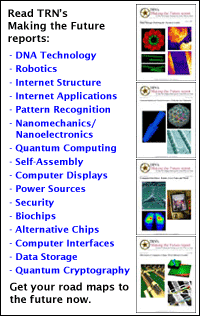
Jolts turn liquid to solid
By
Kimberly Patch,
Technology Research NewsThe three states of matter -- solid, liquid and gas -- are usually quite distinct.
Researchers from Hong Kong University in China, however, have blurred the lines with a liquid concoction that ordinarily has the viscosity of silicone oil, but in the presence of an electric field becomes as solid as hard rubber.
The method employs a relatively new ingredient -- nanoparticles -- to bring about an especially strong electrorheological effect. Nanoparticles are bits of matter that are not much larger than molecules. The electrorheological effect, which causes particle-filled liquids to solidify in the presence of electrical field, was discovered about 60 years ago, but until now was only able to bring about solid-like states as strong as firm tofu, said Ping Sheng, a professor of physics at Hong Kong University in China.
The researchers' method could eventually be used to make mechanical devices like dampers, valves and clutches that respond quickly and automatically to environmental changes. "Sensors can sense environmental variations and generate electrical signals; these electrical signals can be converted into mechanical property variations through the electrorheological effect, which in turn can generate -- very quickly -- mechanical responses," said Sheng.
More than a decade ago, researchers attempted to harness the effect for practical applications like car breaks, but the efforts failed, according to Sheng. Nanotechnology enabled the breakthrough, he said. The researchers' coated nanoparticles measure 53 to 80 nanometers in diameter, or 1,000 times smaller than the diameter of a hair.
The change from liquid to solid and back takes place within a hundredth of a second and requires a relatively small electric current, said Sheng. About 8 thousandths of a watt will turn a square centimeter of the nano particle mixture solid, he said. The power drawn by an 80-watt light bulb will turn a square meter's worth of the mixture solid.
Although the transition from liquid to solid happens quickly, it is continuous rather than abrupt, making it especially useful for dampening devices, said Sheng.
The researchers' mixture consists of nanoparticles coated with urea and suspended in silicone oil. The keys to the strength of the mixture's solid phase are the smallness of the particles and the urea coating. The principal behind the change is the electrical force, said Sheng.
The electrical force holds atoms together and is one million trillion trillion trillion times stronger than the gravitational force. In everyday life, however, we feel gravity as weight, but can hardly feel any strong electrical forces, said Sheng. "The reason is... that the positive and negative charges in our universe are very finely balanced and their electrical forces nearly canceled," he said.
This makes the electrical force extremely weak at distances larger than atomic and molecular dimensions, but it can be very strong at the nanoscale, said Sheng. The strong electrical force is responsible for the strength of all solids.
Urea molecules contain a strong dipole moment, or pair of magnetic poles. In an electric field, the nanoparticles become polarized, and like kitchen magnets that stick together, neighboring particles pull together to form chains. The chains align along the direction of the electric field. The urea coating's dipoles form two aligned layers at the point where two nanoparticles come into contact, said Sheng.
This makes for a strong connection, said Sheng. "The electric field between the particles is then essentially that between the two molecular dipole layers, which can be very large," he said.
The chains coalesce into columns that transmit shear, which is a characteristic of solids. Shear can cause a solid to twist, for instance.
The researchers coated the nanoparticles using a self-assembly process. This makes the nanoparticles somewhat self-repairing as well, he said. "We have observed that if we apply a very large electric field the... fluid would break down. But after removing the voltage and stirring the mixture a bit, the... fluid can function as usual without observable degradation," he said.
In addition, the coating is relatively soft, which will prevent wear from friction during applications that stress the solid state, according to Sheng.
The researchers are working to develop prototype devices that take advantage of the liquid-solid material, said Sheng. They are also working to better understand the interaction of the coating and the nanoparticle, he added.
The material can be used in some practical materials applications within two years, and in devices within five years, according to Sheng. "For certain applications, such as clutches, dampers and valves, we [need to] consider development of the basic device structures," he said.
In addition, the material will enable new applications, including those that can take advantage of an electro-mechanical interface, said Sheng. "Many of the applications are yet to be developed or even thought of," he said.
Sheng's research colleagues were Weijia Wen, Xianxiang Huang and Shihe Yang from the Hong Kong University of Science and Technology and Kunquan Lu from the Chinese Academy of Sciences. The work appeared in the October 5, 2003 issue of Nature Materials. The research was funded by The Hong Kong University Grant Committee, the Hong Kong Research Grant Council, and a business investor.
Timeline: > 2 years; > 5 years
Funding: Private, University
TRN Categories: Materials Science and Engineering
Story Type: News
Related Elements: Technical paper, "The Giant Electrorheological Effect in Suspensions of Nanoparticles," Nature Materials, October 5, 2003
Advertisements:
November 19/26, 2003
Page One
Segway robot opens doors
Jolts turn liquid to solid
Switch promises optical chips
Physics tackles processor problem
Briefs:
Molecular memory is electric
Liquid crystal tunes fiber
Nanotubes fortify plastic film
Plastic display circuit shines
Model leverages nano tethers
Stamp forms organic laser
News:
Research News Roundup
Research Watch blog
Features:
View from the High Ground Q&A
How It Works
RSS Feeds:
News
Ad links:
Buy an ad link
| Advertisements:
|
 |
Ad links: Clear History
Buy an ad link
|
TRN
Newswire and Headline Feeds for Web sites
|
© Copyright Technology Research News, LLC 2000-2006. All rights reserved.